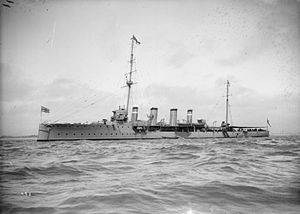Boadicea-class cruiser

Boadicea at anchor
|
|
| Class overview | |
|---|---|
| Operators: |
|
| Preceded by: | Sentinel class |
| Succeeded by: | Blonde class |
| Built: | 1907–10 |
| In commission: | 1909–26 |
| Completed: | 2 |
| Scrapped: | 2 |
| General characteristics (as built) | |
| Type: | Scout cruiser |
| Displacement: | 3,350 long tons (3,400 t) (normal) |
| Length: | 405 ft (123.4 m) (o/a) |
| Beam: | 41 ft 6 in (12.6 m) |
| Draught: | 14 ft (4.3 m) |
| Installed power: |
|
| Propulsion: |
|
| Speed: | 25 knots (46 km/h; 29 mph) |
| Range: | 4,260 nautical miles (7,890 km; 4,900 mi) at 10 knots (19 km/h; 12 mph) |
| Complement: | 317 |
| Armament: |
|
| Armour: |
|
The Boadicea-class cruiser was a pair of scout cruisers built for the Royal Navy in the first decade of the 20th century. They were the first class of this type to be fitted with steam turbine machinery. Upon completion in 1909–10, the sister ships served as flotilla leaders for destroyer flotillas of the First Fleet until 1913 when they were assigned to battleship squadrons. When the First World War began in August 1914, they remained with their squadrons as the First Fleet was incorporated into the Grand Fleet, although they changed squadrons over the course of the war. Both ships were present during the Battle of Jutland in mid-1916, but neither fired a shot. They were converted into minelayers the following year and both ships laid minefields in early 1918 in addition to other missions. The sisters were reduced to reserve in 1919 and sold for scrap in 1921 and 1926.
Like the earlier scout cruisers, the Boadicea class was designed to provide destroyer flotillas with a command ship, theoretically offering the ability to scout ahead of the group and locate targets for the smaller ships to attack. They were enlarged and more powerfully armed versions of the earlier ships, fitted with steam turbines. Curiously, they were no faster than the older ships and equally unsuccessful in their intended role as they lacked the speed of the destroyers they were supposed to escort.
Displacing 3,350 long tons (3,400 t), the ships had an overall length of 405 feet (123.4 m), a beam of 41 feet 6 inches (12.6 m) and a deep draught of 14 feet (4.3 m). They were powered by two sets of Parsons steam turbines, each driving two shafts. The turbines produced a total of 18,000 indicated horsepower (13,000 kW), using steam produced by 12 Yarrow boilers that burned both fuel oil and coal, and gave a maximum speed of 25 knots (46 km/h; 29 mph). They carried a maximum of 780 long tons (790 t) of coal and 189 long tons (192 t) of fuel oil that gave them a range of 4,260 nautical miles (7,890 km; 4,900 mi) at 10 knots (19 km/h; 12 mph). Her crew consisted of 317 officers and enlisted men.
...
Wikipedia
